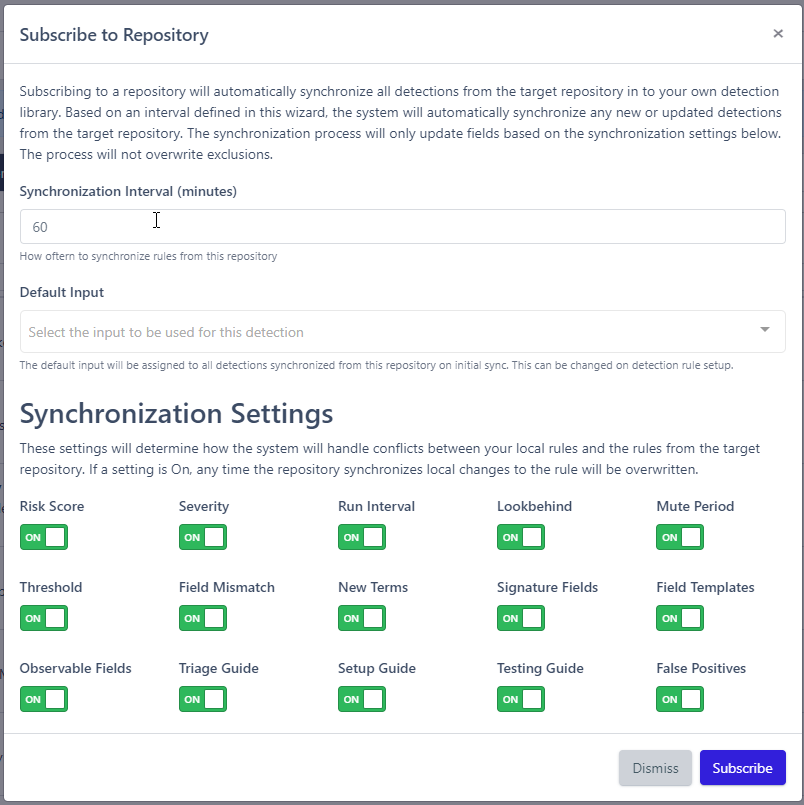Detection Repositories
Detection Repositories allow you, as a global tenant, to share Detection Rules with your subtenants. This means your sub tenants won't have to manually create their own Detection Rules, and that any new Detection Rules you create will automatically be applied to the respective subtenant(s).
Creating Detection Repositories
To create new Detection repositories, the followings steps can be used:
- Navigate to the Detections page
- Click
Detection Repositories - Click
New Repository - Click
Createafter filling out the necessary information
Subscribing to a Repository
Subscribing to a Repository will automatically sync all Detections from the target Repository to your own Detection library. When subscribing to a Detection Repository, you can define a field called Synchronization Interval (minutes) which will determine how often you wish to synchronize new and updated Detections from the subscribed Repository.
Warning
Any local changes that have been made to the Detection Repository will be overwritten during synchronization.
However, you can also choose which updates you would like to synchronize. Looking at the image below, there are certain fields you can choose to sync or not sync with the subscribed Repository. For example, you can choose to disable the synchronization of the Risk Score if you are happy with the original.

Disabling Synchronization of the Base Query
One thing you can NOT disable is the synchronization of the Detection's base query.
Deleting Detections from a Repository
Detections from a currently subscribed Repository can NOT be deleted from your library of Detections. If you wish to delete a Detection, you must first unsubscribe from the Repository. Utilizing Exclusions is the best way to make Detection Repositories work best for your Organization.
Manual Synchronization
Even though Reflex with automatically synchronize subscribed Detection Repositories based on the Synchronization Interval (minutes) field, you can also choose to manually sync them at any point. To do this, the following steps can be used when logged into Reflex as the Admin user:
- Navigate to the Detections page
- Click
Detection Repositories - Click
Manageon any of the Detections - Select
Synchronize Now
Adding Detections to a Repository
When adding new Detections to the Default Organization, an Agent will automatically assess that Detection in a disabled state for 60 minutes. This ensures the Detection is not going to trigger an excessive amount of Events. Once the assessment is complete, if it is not flagged for high-volume, then it will automatically be enabled. Additionally, if the base query of the Detection is modified, the assessment process will repeat.
To add Detections to a Repository, the following steps can be used:
- Navigate to the Detections page
- Select the Detections to add to the Repository using the checkbox to the left of the names
- Click
Bulk Actions - Select
Add to Repository
Repository Types
There are two types of Repositories:
local: exist in the Reflex tenant and can be shared cross-organizationremote**: exist in the Reflex tenant and can be shared across other Reflex instances
**remote Repositories are still in development and will be coming to production soon!
Access Permissions
There are two access permissions available per type:
local
private: only accessible by your organizationlocal-shared: accessible to all tenants in the Reflex instance- Access Scope: defines what Organizations can access and synchronize the Detections in the Repository. By default, this is left empty, meaning all tenants in the ReflexSOAR instance can access and synchronize the Detection Repository.
remote**
external-private: accessible with an access key and URLexternal-public: accessible by anyone with the URL
**remote Repositories are still in development and will be coming to production soon!
Q & A
1. What happens when access is revoked to a Repository?
- When access to a Detection Repository is revoked, all the previously synchronized rules are unlinked from the Repository and can now be directly edited.
2. What counts as access revocation?
- If the author of the Detection Repository removes your organization from the Repository's access scope
- If the author of the Detection Repository deletes the Repository
3. If I subscribe to a Detection Repository, can I pick and choose which Detections to use?
- No; a Detection provide by a subscribed Repository cannot be modified or deleted unless you unsubscribe from the Repository first. Then, a copy of the Detection will be made available for modification or deletion.
4. How can I modify a Detection in a Repository to make it work for me?
- The best way to leverage Detections derived from a Detection Repository is to utilize Exclusions. To do this, locate the Detection Rule you wish to add an Exclusion to, click
Manage|Edit Detection, selectExclusions, and clickNew Exclusion.